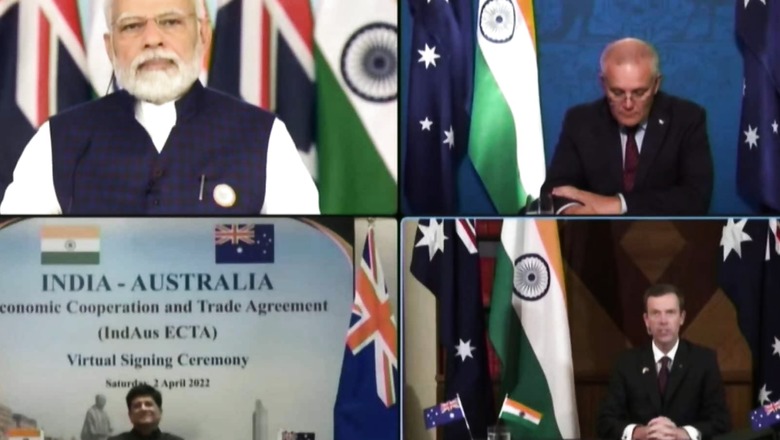
views
Two of the largest middle power democratic nations of the Southern hemisphere, Australia and India, will start navigating more ways across the vast Indian Ocean Region, creating synergies not witnessed before, opening significant opportunities. Both countries signed a historical India-Australia Economic Cooperation and Trade Agreement (ECTA) on 02 April 2022, an auspicious day, for it was the start of the Navratri festival and the first business day in the Indian businesses’ Financial Year.
This historic Ind-Aus ECTA which has been over ten years in the making, got a significant thrust to move ahead in 2021 with the appointment of former Australian PM Tony Abbott as the Special Envoy for the Australian Government led by PM Scott Morrison, who himself was Immigration and Border Protection Minister under PM Abbott. ECTA is now getting actively implemented with the visit by India’s Commerce Minister Piyush Goyal to Melbourne from 6 April to 8 April 2022 along with a very large delegation of 58 business leaders. Minister Goyal met with his Australian counterpart Trade Minister Dan Tehan MP and Special Envoy Tony Abbott. Coincidentally, Ind-Aus is also pronounced as Indus, the river originating from the Himalayan snow mountain ranges, that marks a civilisation that lasted from 3000BCE to 1300BCE, while ECTA when pronounced as “Ekta”, means Oneness or Solidarity as in complete unity and support for each other in the ancient Indian language Sanskrit.
Also Read: India is Fast Becoming a Regional Security Power, Trade Deal with Australia Affirms That
Minister Goyal started his Australian visit after signing ECTA, by addressing the apex, pre-eminent Australia India Chamber of Commerce (AICC) at the historical MCG venue on 6 April 2022, sharing his views with the gathering of key business leaders from both countries. This important journey started with the CECA (Comprehensive Economic Cooperation Agreement) announcement during PM Modi’s first official visit to Australia for the G20 Summit held in Brisbane in November 2014. Piyush Goyal emphasised the role of AICC as a key stakeholder that represents important Australian businesses already engaged with India and those who are ready to ride the waves across the vast Indian Ocean maritime domain. At this event, another historical MOU has been signed between AICC and the Confederation of Indian Industry (CII) to facilitate the members of both organisations to actively engage in future partnerships.
It is understood that the defence partnerships will be very important, due to the boost it has received by the signing of the Comprehensive Strategic Partnership (#CSP) and nine related agreements on 4 June 2020 at the Virtual Summit between the Prime Ministers of both countries. Such increased defence cooperation was witnessed with the Australian Navy’s participation in the Malabar exercises and MILAN2022 hosted by India, while the Indian Air Force and Indian Army participated in Operation Pitchblack, and Kakadu exercises hosted by Australia. Also, the recent announcement during the Second Virtual Summit of both Prime Ministers of the visit by the Indian Navy’s Poseidon aircraft to Australia for training and interoperability exercises will help strengthen the security of the IOR trade routes and SLOCs in the decades ahead.
As National Convenor of the AICC Defence Working Group, I brought out some of these key Defence and Maritime domain security issues at the AICC event hosted in Canberra with former Governor-General and CDF of Australia, General Sir Peter Cosgrove, AK, AC (Mil), CVO, MC, (Retd).
A historical MOU signed on 23 September 2021 between the Australian Industry & Defence Networks (AIDN) with the Society of Indian Defence Manufacturers (SIDM), facilitated by Arzuh International based in Brisbane also opens up significant opportunities for Defence R&D between both countries to include equipment such as Australian drones, besides cybersecurity and AI providers to invest into India directly with the increased FDI limits from 49% to 74% recently, a major departure from the earlier policies. This will increase Australian participation in Indian Atmanirbharta (Self Reliance) initiatives and enable them to Make in India for the World.
The Australia Economic Strategy to 2020 report authored by Former Indian Ambassador Anil Wadhwa, provides valuable insights and provides an important roadmap for all Indian businesses to engage across the Australian industry spectrum with priority assigned to different sectors. The Australian government had also issued in 2018 its own India Economic Strategy to 2035 – Navigating from Potential to Delivery for which an important update was released in Melbourne on 22 March 2022. This update has responded to the rapidly changing global developments, the need to ensure safe and secure supply chains and the ongoing Indian reforms and developments in the country. Australia also announced initiatives in the update, totaling US$210 million, to address the bilateral investment cooperation in emerging sectors such as critical minerals, clean energy, cyber and critical technologies, and space as well as the priority sectors of infrastructure, education, tourism, agribusiness, and energy. During their second Virtual Summit held on 21 March 2022, the two Prime Ministers agreed to boost cooperation in critical minerals and mobility of students and professionals.
As highlighted by Former Indian Ambassador Anil Wadhwa, IFS, the goods, services, trade remedies, rules of origin, sanitary and phytosanitary measures, technical barriers to trade, customs procedures and trade facilitation, and legal and institutional issues including dispute settlement, temporary movement of natural persons have been included in the agreement, which will cover most items of bilateral trade. Specific areas of interest to both sides in the services sector such as financial services, telecommunication services, professional services, and foreign investment framework are spelled out. Over 96.4% of Indian goods by value (98% by tariff lines) will get zero-duty access on day one of the pacts coming into force, with the rest set for phased concessions. There will be immediate NIL duty on 85% of Australian exports from the first day, and NIL to low duty on 30% tariff lines in 3-10 years. India will gain from duty-free access for a host of labor-intensive sectors like textiles, gems, and jewellery, leather, and footwear and from a liberalised visa regime allowing easier movement of professionals. Sensitive sectors like dairy, sunflower oil, wheat, rice, walnuts, medical devices, beef, etc., have been kept out of the agreement, while Australian wines will see reduced duty from 150% to 25% over a period of 10 years in two categories, thus taking care of the Indian domestic wine industry. Australian coal which attracts 2.5% duty will also enjoy duty-free access. The rationalization or elimination of tariffs will boost existing bilateral trade and encourage investments in both countries.
Liberalisation of the services sector with enhanced Indian access in about 135 sub-sectors and MFN status in 120 subsectors, as well as market access to Australia in 103 subsectors and MFN status in 31 sub-sectors from the 11 broad service sectors will encourage the flow of professionals and lead to reinforcement of each other’s economies. Corporates in India and Australia will now look at the opportunities provided by this agreement with renewed interest.
Healthcare sector imports from India and shifting manufacturing bases from China to India are immediate opportunities for Australian companies, besides the 6,000+ items of trade with reduced tariff barriers between both countries under this historical IndAus ECTA.
Thus, India and Australia, while strengthening the Quad are also entering a new and exciting phase in their relationship that promises to be a win-win situation for both countries, increasing B2B and people-to-people (P2P) engagements.
The author is the Founder & CEO of Arzuh International, based in Brisbane providing Strategic Transaction Advisory Services. The views expressed in this article are those of the author and do not represent the stand of this publication.
Read all the Latest Opinion News and Breaking News here




















Comments
0 comment